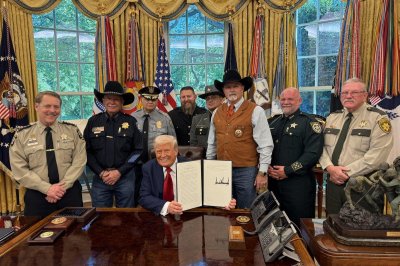
April 29 (UPI) — President Donald Trump signed a trio of executive orders on Monday that target sanctuary cities, increase English proficiency requirements for truck drivers and a third to protect police from consequences of wrongdoing.
Since returning to office nearly 100 days ago, Trump has ruled via executive orders, signing more than 140 of them in that time span. Some have been challenged in court.
Sanctuary cities
As part of his crackdown on immigration, Trump on Monday signed an executive order directing Attorney General Pam Bondi and Homeland Security Secretary Kristi Noem to compile a list of so-called sanctuary states, cities and jurisdictions for punishment.
Sanctuary cities are those that limit or outright deny cooperation with federal immigration law enforcement.
Under the executive order, jurisdictions found to be violating immigration federal law may lose federal funding. Bondi and Noem are instructed to develop mechanisms to ensure “proper eligibility verification in sanctuary jurisdictions to prevent illegal aliens from receiving federal public benefits,” according to a White House fact sheet on the order.
“It’s quite simple,” White House press secretary Karoline Leavitt said during a press conference on Monday. “Obey the law, respect the law and don’t obstruct federal immigration officials and law enforcement officials when they are simply trying to remove public safety threats from our nation’s communities.”
The move is expected to attract lawsuits.
The New York Immigration Coalition described the executive order as being designed to “punish” local governments for establishing their one public safety policies and standing up to the Trump administration’s mass deportation plan.
“This executive order is nothing more than an intimidation tactic designed to undermine the ability of local governments to enact policies they believe best safeguard their communities, while strong-arming localities into becoming complicit with Trump’s attacks on immigrants,” NYIC President and CEO Murad Awawdeh said in a statement.
“New York must reject this threat to its constitutional right to pass local laws that serve our communities best.”
The Trump administration is seeking to deport millions of undocumented migrants and has led a campaign that has seen many arrested, including more than 200 who were shipped to El Salvador and are being held in a mega-prison, raising concerns over due process rights.
Amid its immigration crackdown, the Trump administration has attacked those who have stood in defiance, suing the city of Rochester over its sanctuary city policy and arresting a Milwaukee judge on accusations of assisting an undocumented migrant in evading capture by federal agents.
Policing
Trump also signed an executive order to “empower state and local law enforcement to relentlessly pursue criminals and protect American communities,” according to a White House fact sheet.
The executive order directs Bondi to create a mechanism to provide officers accused of wrongdoing with legal resources, including pro bono assistance.
It also calls for a review of federal consent decrees, out-of-court agreements and post-judgment orders involving state or local law enforcement agencies and to either modify or rescind any that “impede the performance of law enforcement functions, the White House said.
It will also increase the provision of surplus military assets to support local law enforcement, among other directives.
The American Civil Liberties Union described the executive order in a statement as one that “seeks to prevent accountability for law enforcement misconduct and encourages police brutality.”
Truck drivers
The third executive order Trump signed Monday directs Transportation Secretary Sean Duffy to issue new guidance increasing English-proficiency requirements for truck drivers.
“President Trump believes that English is a non-negotiable safety requirement for professional drivers, as they should be able to read and understand traffic signs; communicate with traffic safety officers, border patrol, agricultural checkpoints and cargo weight-limit station personnel; and provide and receive feedback and directions in English,” the White House fact sheet said.
During the Monday press conference, Leavitt described the English-proficiency of truck drivers as being “a big problem.”
“Unless you’re in that community you might not know but there’s a lot of communication problems between truckers on the road with federal officials and local officials as well, which, obviously, is a public safety risk, so we’re going to ensure that our truckers, who are the backbone of our economy, are all able to speak English.
“That’s a very common-sense policy,” she said.